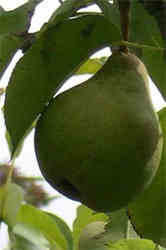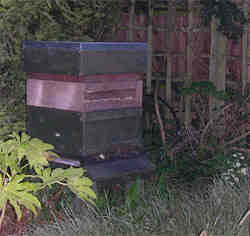Pear and Lemon Jam Recipe
Posted by Fiona Nevile in Jam Jelly and Preserves | 152 comments
A pear hanging on our pear tree
I spent ages trying to find a recipe for pear jam without success. One day moseying in the recipe section of Waitrose, I spotted a copy of the best selling Italian cook book The Silver Spoon. Leafing through the pages I found a recipe for pear jam. It was hard to justify buying yet another cookbook, so I memorised the ingredients. Somewhere between Waitrose and our kitchen I added one more.
I made an excellent jam, not too sweet. A lemony taste with tiny explosions of pear. Everyone that tasted it wanted the recipe. It’s our favourite jam, good for breakfast or with a mild soft cheese.
The problem was that I hadn’t written the recipe down and wasn’t sure of the volume of water. When I returned to Waitrose “The Silver Spoon” was no longer on the shelves. Finding the book became a real mission. I saw it advertised on hoardings in the London tube but never found it in a shop. One happy day, I saw “The Silver Spoon”, twinkling from the supermarket shelves. I snapped it up and rushed home.
I was astonished to find that water was not an ingredient of the jam! I tried several versions, with different amounts of water, and this is by far the best.
| Pear and Lemon Jam Recipe |
- 2 kilos (4 and 1/2 pounds) of pears, peeled, cored and chopped
- 3 medium lemons (strained juice and zest)
- 1 kilo (5 and 1/4 cups) of granulated jam sugar
- 250ml water
Method
- Prepare the pears and place in a large covered bowl, to stop them browning.
- Remove the zest from the lemons carefully to avoid adding the bitter pith. Set zest aside.
- Squeeze the lemon juice and strain.
- Add the water, chopped pears, lemon zest and juice to a large heavy bottomed saucepan.
- Simmer very gently until the pears are just soft.
- Pour in the sugar and stir over a medium/low heat until the sugar is dissolved.
- Bring the heat up to a rolling boil (what is a rolling boil? See Tricks and tips below).
- Allow to boil hard for ten minutes before testing for a set.
- If it has not reached setting point (what is setting point? See Tricks and tips below) continue to boil rapidly, checking for a set every four minutes or so (set the timer for this).
- When the jam has set remove from the heat.
- Allow the jam to stand for a few minutes and pour into warmed sterilised jars (how do I sterilise jars? See Tricks and tips below).
- Cover with screw top lids or wax disks and cellophane tops.
- Label when cold.
- Store in a cool dry place.
Tricks and tips:
Jam set or ‘setting point’
Getting the right set can be tricky. I have tried using a jam thermometer but find it easier to use the following method.
Before you start to make the jam, put a couple of plates in the fridge so that the warm jam can be drizzled onto a cold plate (when we make jam we often forget to return the plate to the fridge between tests, using two plates means that you have a spare cold plate).
Return the plate to the fridge to cool for approx two minutes.
It has set when you run your finger through it and leave a crinkly track mark.
If after a few minutes the cooled jam is too liquid, continue to boil the jam, testing it every few minutes until you have the right set.
The jam is far more delicious if it is slightly runny.
There are other indicators the the jam is setting, the jam will start to coat the back of the spoon and the sides of the saucepan.
Sterilising the jars
We collect jars all year round for our jelly, chutney and jam making sessions. I try to soak off labels and store the clean jars and metal plastic coated lids in an accessible place.
The sterilising method that we used is simple. Just before making the jam, I quickly wash and rinse the jars and place them upside down in a cold oven. Set the temperature to 160c (320F) 140c fan assisted).
When the oven has reached the right temperature I turn off the heat. The jars will stay warm for quite a while.
I only use plastic lined lids for preserves as the all-metal lids can go rusty. I boil these for five minutes in water to sterilise them. If I use Le Parfait jars, I do the same with the rubber rings.
What is a rolling boil?
This is when you boil your jam (or jelly) continuously, very hard. This gradually evaporates the water, enabling the jam to set.
Leave a reply






Jackie,
The recipe as it stands is just the right level of sweetness and not really lemony. Bizarrely it has a hint of spice, a bit like allspice even though it has none in it. I wonder whether that is a combination of the fruit and caramelised sugar.
Has anyone tried the recipe with less lemon? I have not made it yet but concerned it is too lemony since my family are not “lemony” people.
Wow, what a fabulously scrummy jam. I’ve just made jam for the first time since I was a child using some pears that we were just not able to eat as we had so many. I’d love to try adding stem ginger, though being a return to jam maker, I’m not sure how much.
Saddly i made this jam today using the last of our pears otherwise i would be making lots more!
I followed the recipe exactly and yes it does take a long time on a hard boil for the water to disappear all i can say is the wait is worth it.
Not only does it taste great it has a lovely colour.
Now what else can i make..
Thanks great recipe.
colleen
I have just finished potting your Pear and lemon jam. Except for adding a half teaspoonful of dry ginger I followed your recipe exactly. It took a long time to reach setting point. I am delighted with the taste and appearance. I normally make just pear and fresh ginger jam, but decided a change was called for. I had thought that the cubed pear may all drop to the bottom of the jars, but it looks great. Thanks for sharing your recipe.
Thanks for the pear and lemon jam recipe. I’m on my second batch but finding it difficult to get it to set. Should I try using less water next time? Any suggestions gratefully received.
Wendy
Hi, like many other visitors to your site, I have been looking for a pear jam receipe for about 3 years. Thank you so much for sharing this with us all. I am going to start my pear jam production next weekend – I will let you know how I get on – I have never made jam before but have always wanted to. I have a conference pear tree in the garden that produces masses of pears each year. I am also going to make a pear chutney for Christmas(I will look through your site for a receipe for that too!). Many thanks again. Debbie.
Hi June
I have never tried warming the sugar in the oven but thanks for the nudge. I’ve heard that it makes the whole process easier.
Hello jubilant cerise
Thanks for the tips on splattering. I make this jam in an enormous high sided saucepan so don’t have a problem with splatters, to date.
Delighted that you liked the recipe!
Hi Phyllis
Thanks for leaving a comment. I do hope that the jam works out well for you.
Hi Fran
I’m not sure, as I’ve never frozen jars of jam. But we were given pate in glass jars today and the chef said that they could be frozen so why not jam. The only thing is you need to allow for expansion of the jam, so leave a decent gap between the jam and the lid (about an inch). NB I’ve just been told that glass jars break easily at freezer temperatures. Its best to use heavy duty canning jars (like Kilner or Mason jars). This jam will keep for at least a year if you seal and store it properly – without the need to freeze.
Can the jars be frozen?
Thank you.
Excited to start….
Can I freeze the jars after they have cooled?
Thanks.